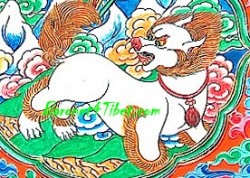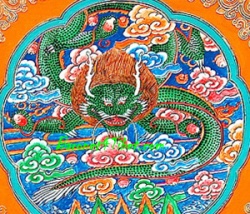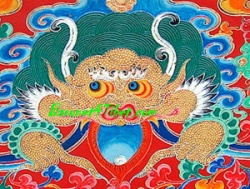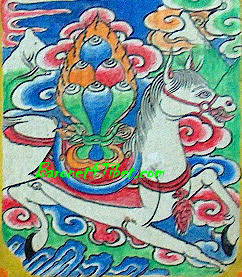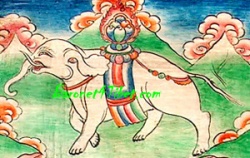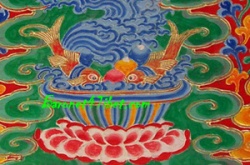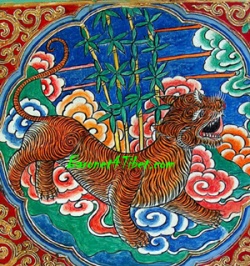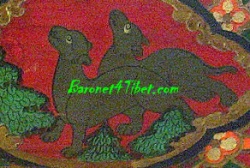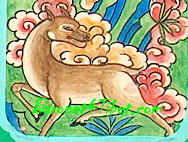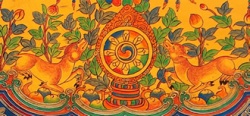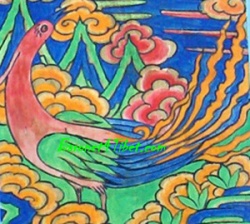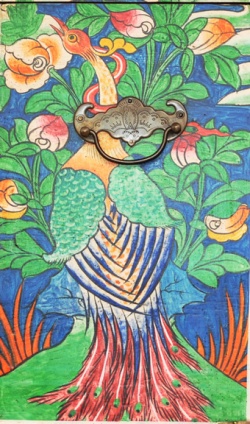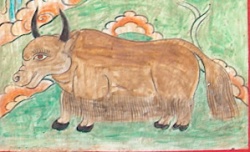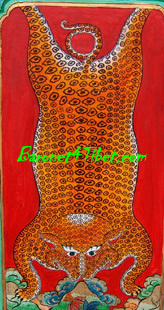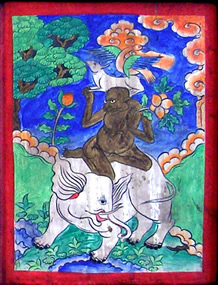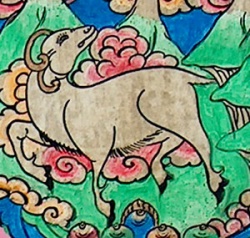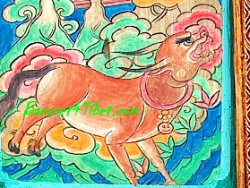Tibetan Buddhist Symbolism - Animals, both real and mythical
Snow Lion
The Snow Lion is the national emblem of Tibet. The Snow Lion resides in the East and represents unconditional cheerfulness, a mind freed from doubt, clear and precise. It has a beauty and dignity resulting from a synchronized body and mind. The Snow Lion has the youthful, vibrant energy of goodness and a natural sense of delight. Sometimes, the throne of a Buddha is depicted with eight Snow lions on it. In this case, they represent the 8 main Bodhisattva-disciples of Buddha Shakyamuni, the historical Buddha. Associations: main quality is fearlessness, dominance over mountains, and the earth element.
Dragon
Unlike its demonic European counterpart, the Tibetan dragon is a creature of great creative power; a positive icon, representing the strong male yang principle of heaven, change, energy, wealth and creativity. Dragons are shape shifters, able to transform at will, from as small as the silkworm to a giant that fills the entire sky. Dragons are depicted in one of two
colors, green or brown. The green, or azure dragon of Buddhism ascends into the sky at the spring equinox; it represents the light's increasing power in springtime and the easterly direction of the sunrise. The brown dragon is the autumn equinox, when it descends into a deep pool, encasing itself in mud until the next spring, but its spirit is still with the practitioner bringing wealth and health. The pearls, or jewels clutched in the claws of the dragon represent wisdom and health. The dragon can control the weather by squeezing the jewels to produce dew, rain or even downpours when clutched tightly. The dragon is the vehicle of Vairochana, the white Buddha of the center or the east.
Zeeba or Zipak
Zeeba or Zipak (Tibetan) The Zipak originates in a Shaivite legend from the Shandha Purana. Shiva created a demon called Jalandhara from the blaze of his third eye. Jalandhara assumed great power and desired an incestuous relationship with Parvati, the consort of Shiva and Jalandhara's adoptive mother. Jalandhara persuaded Rahu, one of his
demonic friends, to demand Parvati's favor. When Shiva got wind of this, he was understandably outraged, so his third eye blazed again, thereby creating the Zeeba, who made a beeline to devour Rahu. Rahu decided that Zeeba was going to eat him bones and all and begged Shiva for mercy; whereupon, Shiva offered forgiveness and called off Zeeba. Because Zeeba had not had anything to eat since coming into the world and had been deprived of his only prey, he turned on himself and devoured his own body until only the head and hands remained. Shiva was very pleased with his handiwork and invited Zeeba to remain as the guardian to his door. Since then, he has become a reminder of the consequences of gluttony and greed and also stands as a guardian of practitioners. Zeeba's fingers point to his missing body to show what can happen when someone is overcome by avarice.
Precious horse
The Precious horse is one of the 7 Precious possessions of Chakravartin.
The Precious Horse is able to travel among the clouds and mirrors the Buddha's abandonment of, or "rising above," the cares of worldly existence. The horse is Chakravartin's riding horse, which is able to circumnavigate the globe 3 times in one day and symbolizes mobility and speed. The Cintamani on the horse's back is a magical jewel with the power to grant wishes, able to fulfill any and all desires, also called the thinking jewel. Jewels in Buddhism are analogous with the importance of teaching, representing also the mind that has attained enlightenment.
Precious Elephant
The Precious Elephant is one of the 7 Precious possessions of Chakravartin.
The Precious Elephant is a symbol of the strength of the mind in Buddhism. Exhibiting noble gentleness, the precious elephant serves as a symbol of the calm majesty possessed by one who is on the path. Specifically, it embodies the boundless powers of the Buddha, which are miraculous aspiration, effort, intention, and analysis. Elephant tusks are sometimes depicted and are symbolic of the whole elephant.
Pair of golden fish
The pair of golden fish. One of the 8-auspicious symbols.
Having complete freedom in water, fish represent happiness, fertility, and abundance. On a spiritual level, they represent the boundless abundance of the Buddha’s energy , which never diminishes, no matter how much is given away.
Tiger
The tiger is a symbol of strength, military prowess. Tigers were indigenous to eastern Tibet, where the Wutun Monastery is located. A more subtle meaning has to do with Tantric Buddhism. Tiger skins were a favored meditational mat for Tantric sages. In Tantric Buddhism, the tiger skin represents the transmutation of anger into wisdom and insight, also offering protection to the meditator from outside harm or spiritual interference. Tiger icons in Tibetan Buddhism are most prevalent in eastern Tibet, appearing on more furniture and rugs here than anywhere else in Tibet.
Mongoose
As a traditional enemy of Nagas and snakes, (both treasure guardians), the mongoose is usually seen spitting out colored jewels of wisdom or Cintamani. The symbol may have its origin in the central Asian custom of using a mongoose skin as a money bag.
Deer
Here we have a single doe. The symbolic meaning is harmony, happiness, faithfulness, peace and longevity; the only attribute that may be absent would be fidelity. Deer, by nature, are extremely shy creatures, and their serene presence in a landscape represents a pure realm absent fear. There are Tibetan tales that tell of deer species so compassionate that they would come and try to resolve any conflict that arose; this of course made them easy prey for hunters.
When two deer are shown, it is usually the male and female and refers to the first teaching which Buddha gave in the Sarnath Deer Park near Varanasi, where he set in motion the "first turning of the wheel of dharma." The picture to the right, two deer facing a Dharma Wheel, is a scene that one could expect to see and does see on the roofs of prayer or assembly halls in monasteries through out Tibet.
Phoenix
The Phoenix is endowed with all of the magical qualities of auspiciousness: longevity, resurrection, the solar and alchemical fire. Like the deer, the Phoenix symbolizes peace and tranquility. Sometimes a similar bird is referred to as the 'Bird of Paradise' with similar meanings.
Peacock
The peacock is a very important bird, 1st it is an emblem of romantic love and beauty. In Buddhism the peacock supports the throne of Amitabha, the red Buddha of the west (main qualities include passion (lotus), love, vital fluids, evening twilight, summer and fire). The peacock is the mortal enemy of snakes, killing cobras with their talons. The main quality of the peacock is transmutation of poison into amrita or nectar. This is tied to Lord Shiva getting a blue throat from taking the poison produced by the churning of the ocean; thus the transmutation of poison or venom by the peacock is said to produce the electric blue of its throat plumage and the wisdom eyes of its tail feathers. In Vajra yana symbolism a bundle of peacock feathers is used as a sprinkler for the consecrated water or amrita contained in the blessing flask. In specific tantric rituals individual feathers are used as fan, mirror, and parasol adornments, also as the feathers for darts, and as the peacock feather parasol used by the goddess Palden Lhamo, symbolizing her wisdom activities and the transmutation of all evils or poisons.
Yak
The yak, a reminder of one of the Tibetan Plateau's most versatile commodities. Until recently, both domestic and wild yaks were found there. The yak is an essential part of the Tibetan diet, providing meat, milk, butter, and dried cheese. The wool is spun to make rope and cloth; the hides are used for tents; bags made from yak hides and fly whisks made from the tails have been exported for years. In the hands of a deity, the fly whisk is a sign of compassion (e.g., "would not hurt a fly"). Yaks are also beasts of burden, pulling wagons and carts.
Leopard's spots
The Leopard's spots resemble (according to Tibetans) the female vagina, consequently the flayed skin of the leopard is more commonly worn by dakinis or wrathful goddesses as a skirt or apron. The large cat skins are most frequently associated with the wrathful deities, Mahakala is usually seen with the tiger skin wrapped around his waist. Victory banners and the asama or meditational seats are also adorned with leopard skins, as are bow quivers. The leopard is also the messenger of the wrathful deities and additionally represents the death of pride, one of the 5 delusions and ultimate emptiness of of this delusion.
Brothers parable
There are at least two versions of the compatible brothers parable, one has 3 brothers and another has 4. The 4 brother story concerns an elephant, a monkey, a hare and a partridge standing on each other's back. One version of the story relates to Shariputra, one of Buddha's oldest disciples, who was unable to find lodging in the village of Vaisali. The younger disciples had all hurried to the town and secured all available lodgings. When Buddha found out that Shariputra had spent the night without shelter beneath a tree, he told the following parable in response to the younger disciples self-cherishing attitude. "Once, beneath a great banyan tree in the Himalayan foothills, there lived 4 friends, a partridge, a hare, a monkey and an elephant. Their mutual respect had diminished, and in order to determine who was the most senior, they began discussing the age of the banyan tree. The elephant first related how, when he was but a baby, the banyan tree was but a small bush. The monkey then related how, in his infancy, the tree was merely a shrub. The hare related how he had seen it as a leafless sapling. Last, the partridge spoke, telling how he had once swallowed the original seed and from his droppings this mighty tree had sprouted. The partridge then was acclaimed the eldest and most honored. Once again, harmony was attained in the kingdom." Buddha then decreed that henceforth age would confer priority within the sangha.
Ram
The rams represent a determination to overcome the 3 poisons of ignorance, desire, and aversion. The flip side of the determination is also represented by the ram and illustrates how the three poisons of ignorance, desire, and aversion give rise to the whole karmic phenomenology of the six realms of cyclic existence. The rams blind following of instinct symbolizes the darkness of primordial ignorance or confusion. The rams desire to mate with the ewes is a symbol of lust or attachment with an insatiable appetite for the fulfillment of its desires and a territorial male aggression that will tolerate no rivalry: in this there is the aversion, hatred or anger which arises from attachment and the unpredictable instinct to strike out at any moment. This is a cyclic phenomenon; the root cause of the primal ignorance gives rise to attachment, which in turn gives rise to aversion, which in turn creates further ignorance: which in the final analysis is a great thing to overcome.
Buffalo
The buffalo is the vehicle or messenger of the Dharmaraja Yama, the Lord of Death. Dharmaraja was subdued by Manjushri in the form of Yamantaka, becoming a protector of dharma practitioners, the name dharmaraja means King of the Dharma. This then is used to take the energy and power of hatred (of things negative or bad) and use this energy to achieve a beneficial purpose. HH explains it this way: With compassion as the causal motivation... the practitioner utilizes hatred or wrath for a specific purpose. This technique is based on the fact that when we become angry, a very energetic and powerful mind is generated. When trying to achieve a fierce activity for beneficial purposes, the energy and power make a difference. Thus it is because of the usage of hatred in the path in this way that there come to be wrathful deities.
